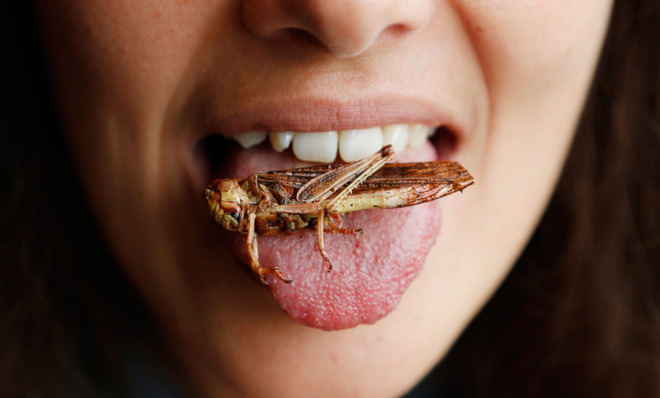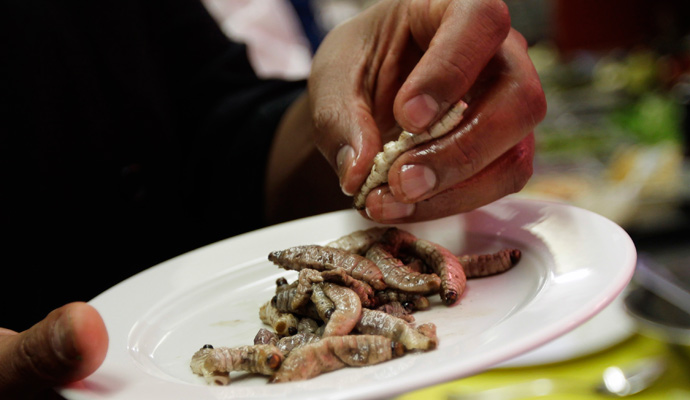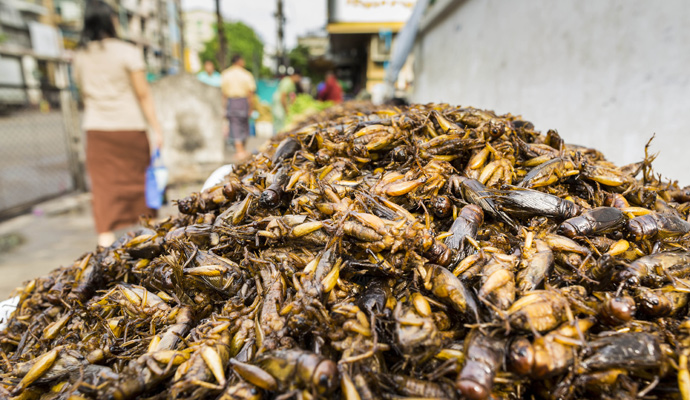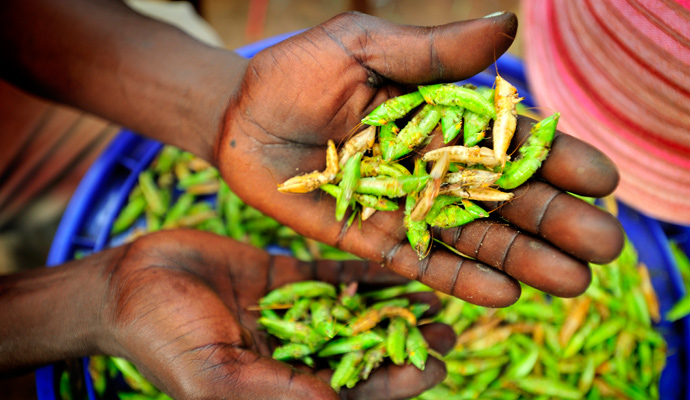The benefits of eating bugs
Meet the new Paleo diet

YOU'VE PROBABLY HEARD of the Stone Age diet craze known as the Paleolithic Diet, made popular most recently by Dr. Loren Cordain's best-seller The Paleo Diet. The premise is simple: If our early human ancestors couldn't have eaten it, we shouldn't, either. It's the one time, it seems, that being like a caveman is a good thing.
The theory goes (and archaeological evidence corroborates) that early hunter-gatherers, while they may not have lived as long, still had some major health advantages on most of us modern humans. They were much taller, averaging 6-foot-5 to our 5-foot-11; had stronger, heavier bones; had more robust immune systems; and were leaner, tougher, and hardier than we are today. Higher levels of physical activity also played a vital role in cave people's vitality, and so did their high levels of wild food consumption: wild game meat, gathered greens and fruits, and healthy fats such as nuts.
Cordain suggests that prior to the agricultural revolution, early humans ate this Paleo Diet for 2.5 million years. The 10,000 years since the popularization of farming — or just 333 human generations — he says, is clearly a drop in the chronological bucket when compared with the millennia leading up to it. Thus, he maintains, the hunter-gatherer diet our ancestors lived on is far more deeply and indelibly imprinted into our DNA than our habits of the last few thousand years. I'm inclined to agree with him. In fact, I'm going to see his 2.5 million years and raise him a few millennia, and show you what we were really designed to eat. The real Paleo Diet would have included bugs. Lots and lots of bugs.
The Week
Escape your echo chamber. Get the facts behind the news, plus analysis from multiple perspectives.

Sign up for The Week's Free Newsletters
From our morning news briefing to a weekly Good News Newsletter, get the best of The Week delivered directly to your inbox.
From our morning news briefing to a weekly Good News Newsletter, get the best of The Week delivered directly to your inbox.
"From the time mammals first appeared until 50 million years ago — a total of 150 million years, three quarters of the entire time mammals have existed — our ancestors were primarily insectivorous," write S. Boyd Eaton and Dorothy A. Nelson in their paper "Calcium in Evolutionary Perspective." "Given the slow and conservative nature of genetic evolution, this long-standing adaptation for insect consumption must have made a significant impact on our genetic heritage. Consequently, the nutritional properties of insects have relevance for understanding the forces that have shaped the nutritional requirements of present-day humans."

IT'S EASY TO OBSERVE this early pre-human diet in the wild today, since versions of this prehistoric bug-guzzler still exist in the form of bush babies, tree shrews, and similar small mammals. It turns out that for a certain size of primate, bugs are one of the best things on the planetary menu. If we were still that size, that's pretty much all we'd eat, too.
But for whatever reason, we grew, in both body and brain size. And as we grew, it became harder to find enough insects to fulfill our daily nutritional requirement. The problem was not with the bugs themselves, but just that we couldn't find enough of them. We had to start branching out. We had to find something more dependable as a source of calories than that which could see us coming and, say, crawl into a hole. So we started eating plants, which, of course, couldn't run away. This is one of the miracles and geniuses of being a primate: our innate adaptability to different diets, also known as omnivory ("omni" = everything, "vory" = eating). We adapted so that we could eat everything and anything and still survive.
We changed inside and out in order to take advantage of the different types of nutrient sources around us, and as we evolved, we took different paths to get there. Some primates adapted internal organs so that they could digest cellulose and extract protein and other nutrients from leaves like herbivores. Some grew long tails and relocated to the treetops, where the good fruit was, and lived off that. Meanwhile others — the ones who eventually became humanity — moved to the savanna, where they could see both prey and predators coming and still find enough vegetable matter to supplement their diets.
A free daily email with the biggest news stories of the day – and the best features from TheWeek.com
But the one thing that none of these versions of ourselves ever stopped eating, at least when they had the chance, was insects. From lemurs and other New World apes, up through Old World apes like chimpanzees and gorillas, up through prehominids, hominids, Neanderthals, and, finally, humans, one thing that unites primatehood throughout the ages is an enduring appetite for bugs.
The main reason for this is that insects are a much higher quality food compared to things like leaves, fruits, flowers, and even nuts. Just like other animals, insects are a trophic level two food source — they themselves have eaten, and thereby concentrated in their own tissues, the nutrients found in plant sources, providing the sorts of things that primates thrive on: protein, iron, calcium, and, best of all, healthy, unsaturated long-chain essential fatty acids (EFAs).
Sure, these nutrients can be found in plant sources, too, but you have to eat a lot more of them. Insects are these scrumptious little compact packages of food that make surviving, and thriving, so much easier for a foraging primate. Nutrition is sort of like money: If leaves represent dollar bills, fruits are fives, nuts are tens, and insects and other forms of animal flesh are crisp fifty-dollar bills. The nutrients in them are just more concentrated and often more bioavailable, which means the body has to do less work to utilize them.

WHEN YOU THINK of the hallmarks of evolution, what image pops up? For many, it's the picture of a chimp with a stick, moistened to catch termites. But like a dog that stares at the pointing finger instead of the ball, we've been focusing entirely on the tool and ignoring its ultimate purpose: to capture and consume insects more efficiently. Scientists in the Congo River Basin have observed chimps utilizing a collection of implements, a "toolkit" if you will, in order to better harvest termites: one short stick to puncture an aboveground mound, and then a longer, slenderer "fishing probe" to pull the termites out. This fishing probe was often further modified to increase its effectiveness. The chimps used their teeth to fray the end like a paintbrush, the better to collect the insects with.
Infant chimps watch carefully as their mothers collect and customize stick tools, find and puncture termite mounds, and deftly extract the crawling black morsels. It is this process of watching, learning, and assimilating through social interaction and observed behavior that many scientists believe to be the roots of civilization.
In fact, as it turns out, the skill of collecting termites is easier observed than done. When the scientists themselves tried to extract termites from the mounds using the same tools and methods the chimps did, they found it quite difficult. "We were less successful than most of the [chimp] youngsters — this is a complex skill that is developed with years of practice," said the appropriately named co-authoring anthropologist Crickette Sanz.
Humanity's great technological and cultural achievements likely began in much the same way. The earliest bone tools found by archaeologists are thought to have been used specifically for insect gathering. A 2001 study on bone tools left behind by Australopithecus robustus, a million-plus-year-old distant relative to modern humans, theorized that they were used to scrape away at termite mounds in order to harvest the inhabitants. This was the first evidence that our early human ancestors were "methodical insectivores."
And it's no wonder, according to paleontologist Lucinda Backwell, who co-authored the study, since termites have a higher nutritional content than rump steak.
"Termites are a valuable source of protein, fat, and essential amino acids, in the diets of both primates and modern humans," wrote Backwell. "While rump steak yields 322 calories per 100 grams, and cod fish 74, termites provide 560 calories per 100 grams."
Let's imagine you are an evolving proto-human, and you have this excellent source of protein, fat, and other nutrients, and it doesn't require you to run, throw a spear, or hold your breath. Insect eating, during the right seasons, is like the drive-through window at McDonald's — a big caloric payoff for comparatively low energetic output.
Cordain and other Paleo Diet advocates and researchers paint a picture of early man as an aggressive and skillful hunter, bringing home piles of meat to his hungry family. But reality was likely quite different. And here is the bug in the system, or, rather, the glaring lack thereof.
As the author of the blog PaleoVeganology quips, "It's as though someone took a big can of Raid to the authors' paleo-imaginations. So steeped are they in their Western food bias and paleofantasies that the possibility of Paleolithic man fulfilling his nutrient requirements with a diet of creepy-crawlies never occurred to them."

HUNTING, ESPECIALLY IN the Neolithic age, was quite a risky activity, from both a safety and an energy investment standpoint. Twisting an ankle in the bush or being injured by a charging animal without any medical care could mean death. It was also a very hit-or-miss sort of activity.
Early hunters experienced about a 20 percent success rate. That means two to three out of every 10 times they ventured out they might return with a big dead animal. Granted, some of these kills would feed the tribe for several days or even weeks, but at those rates, they would have starved if not for the steady stream of calories brought in by gathered and foraged food, such as tubers, greens, and small animals that included, to a large extent, insects and other invertebrates. On a day-to-day basis, things like insects would have been regular fare, the kinds of things that kept early people going between big kills.
In order to do this type of gathering, though, an animal had to be able to hold things in its hands and still travel. It had to be able to walk upright — you try walking on all fours while holding something in your hands. It's even been suggested that the gathering of things like insects would have influenced our shift to bipedalism. Yes, you could, if you wanted to, even partially credit bugs with your ability to walk.
Since it was usually the men doing the hunting (this is the case even in chimpanzee communities), the women would have been the ones gathering, as it's something that can be done with a baby on your back. While the men went out and often came back empty-handed, the women came home every day with at least something to feed the tribe, their mates, and, most important, their children. The majority of the day-to-day protein was actually provided by women and, potentially, largely through insects.
A four-year study on savanna chimpanzees, conducted by anthropologists Jill Pruetz and Paco Bertolani, yielded the observation that it is the female chimps, by and large, who use tools to hunt, not the males. They concluded that this discovery supports a theory that females played a significant role in the evolution of tool technology among the earliest humans.
Oh, how times have changed: When an early female hominid saw a bug and shrieked, it was in excitement, because hey, lunch.
Excerpted from Edible: An Adventure into the World Of Eating Insects and the Last Great Hope To Save the Planet with permission of Amazon Publishing/New Harvest. ©2014 by Daniella Martin. All rights reserved.
-
 ‘Care fractures after birth’
‘Care fractures after birth’instant opinion Opinion, comment and editorials of the day
-
 Shots fired in the US-EU war over digital censorship
Shots fired in the US-EU war over digital censorshipIN THE SPOTLIGHT The Trump administration risks opening a dangerous new front in the battle of real-world consequences for online action
-
 What will the US economy look like in 2026?
What will the US economy look like in 2026?Today’s Big Question Wall Street is bullish, but uncertain